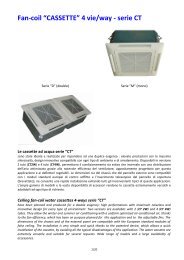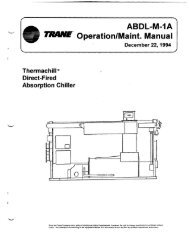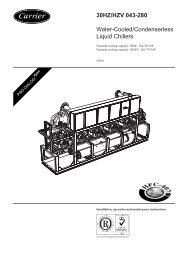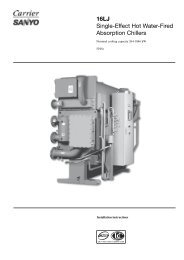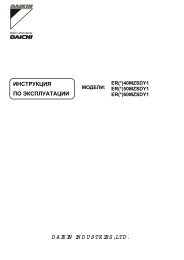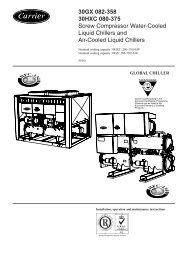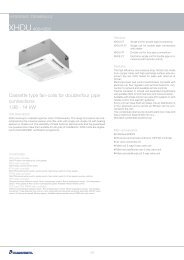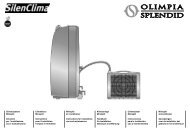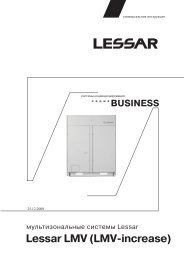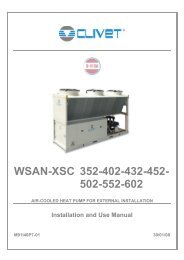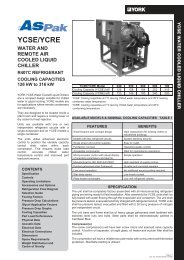"A" Ductable Liquid Chillers with Integrated Hydronic Module
"A" Ductable Liquid Chillers with Integrated Hydronic Module
"A" Ductable Liquid Chillers with Integrated Hydronic Module
You also want an ePaper? Increase the reach of your titles
YUMPU automatically turns print PDFs into web optimized ePapers that Google loves.
Pressure12 - MAINTENANCEAny technician attending the machine for any purpose must befully qualified to work on refrigerant and electrical circuits.All refrigerant charging, removal and draining operationsmust be carried out by a qualified technician and <strong>with</strong> thecorrect material for the unit. Any inappropriate handling canlead to uncontrolled fluid or pressure leaks.WARNING: Before doing any work on the machine ensurethat the power is switched off. If a refrigerant circuit is opened,it must be evacuated, recharged and tested for leaks. Beforeany operation on a refrigerant circuit, it is necessary toremove the complete refrigerant charge from the unit <strong>with</strong> arefrigerant charge recovery group.12.1 - General maintenance of the refrigerant circuitWARNING: To ensure proper operation of 30RY units theremust be at least 12 K of subcooling as the liquid refrigerantenters the expansion valve.The 30RY units use refrigerant. For your information, we arereproducing here some extracts from the official publicationdealing <strong>with</strong> the design, installation, operation andmaintenance of air conditioning and refrigeration systemsand the training of people involved in these activities, agreedby the air conditioning and refrigeration industry.12.3 - Apparent and actual subcooling32541• Keep the unit itself and the space around it clean and freeof obstructions. Remove all rubbish such as packingmaterials, as soon as the installation is completed.• Regularly clean the exposed pipework to remove all dustand dirt. This makes detection of water leaks easier, andthey can be repaired before more serious faults develop.• Confirm that all screwed and bolted connections andjoints are secure. Secure connections prevent leaks andvibration from developing.• Check that all insulation joints are securely closed andthat all insulation is firmly in place. Check all heatexchangers and all pipework.If water jets are used inside the units (e.g. to clean the coils), thelower holes (for possible condensate removal) must be blocked.12.2 - Verification of the refrigerant chargeCAUTION: The 30RY units are supplied <strong>with</strong> a preciserefrigerant charge (see Physical Data table).To verify the correct system charge prodeed as follows:Ensure that no bubbles appear in the sight-glass, when operatingthe unit at full load for a while, at a saturated condensingtemperature of between 55 and 57°C. If necessary cover asection of the coil surface to obtain this condensing temperature.Under these conditions the apparent subcooling which isequal to the saturated condensing temperature (1 - on thesaturated dew point curve) minus the liquid refrigerant temperature(3) ahead of the expansion device must be between 12and 14°C. This corresponds to an actual subcooling temperatureof between 5 and 7 K at the condenser outlet, depending on theunit type. Actual subcooling is equal the saturated liquid temperature(2 - on the saturated bubble point curve) minus theliquid refrigerant temperature (3) ahead of the expansion device.Use the pressure tap supplied on the liquid piping to chargerefrigerant and to find out the pressure of the liquid refrigerant.If the subcooling value is not correct, i.e. lower than the specifiedvalues, a leak detection test must be carried out on the unit,as it no longer contains its original charge.In order to measure the liquid refrigerant pressure and temperatureahead of the expansion device, an access port must beopened on the expansion device which causes a slight airbypass on the condenser. Wait until unit operation has stabilizedbefore carrying out pressure and temperature measurements.L6L + VEnthalpyLegend1 Saturated condensing temperature at the dew point2 Saturated liquid temperature at the bubble point3 <strong>Liquid</strong> refrigerant temperature4 Saturation curve at the dew point5 Saturation curbe at the bubble point6 Isotherms7 Apparent subcooling (1 - 3)8 Real subcooling (2 - 3)L <strong>Liquid</strong>L + V <strong>Liquid</strong> + vapourV VapourV24



